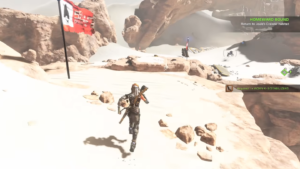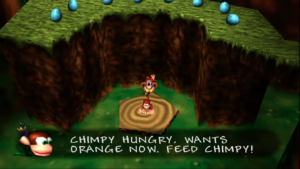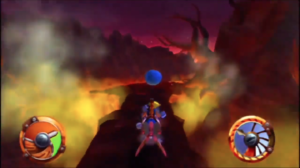Jak and Daxter: The Precursor Legacy is one of my most fondly remembered childhood games. Although I never finished it, I adored it’s story, characters, world and art style. I even loved the gameplay loop of solving a puzzle, collecting power cells, and opening up the next area with them through a thrilling vehicle section. It appears perplexing at first glance then, when ReCore failed to replicate the enjoyable action of going on a collectible hunt to progress. To understand where they went wrong, and how it led to the game’s status at a critical and a financial flop, we should have look at what previous games within this collectathon sub-genre did differently.
The first thing you’ll notice about ReCore, is that it’s environments are very bland and similar. It’s set on a desert planet called Far Eden; on which an attempt to terraform has gone awry. In context, the game’s bland look and colour palette makes sense: but that doesn’t mean it’s enjoyable to look at. It’s all sandy, metallic, industrial areas, with a bit of sci-fi neon lighting thrown in some areas. Despite the world having multiple areas, not enough is done to visually distinguish one from another in a memorable way.

Alternatively, Both Jak and Daxter and Banjo-Kazooie succeeded in making varied environments. Whilst both are very colourful, being games aimed towards children, their environments do not stick to one colour palette like ReCore. Geyser Rock looks very different to Misty Island or the Fire Canyon, and those are all part of the first few hours of the game. Similarly, Banjo-Kazooie’s worlds are all based on a unique theme: Treasure Trove Cove is centred on Swashbuckling Pirates, Click Clock Wood is a forest where you’d probably find Bambi frolicking, and Mad Monster Mansion is… well a spooky mansion. But the point is that the locations are all visually different to one another, in colour palette and visual design.
I look at some of ReCore’s area names and I am compelled to sleep: The Cradle, The Warren, Pylon 512 and The Granite Steps. It all feels like it belongs in some city planning booklet rather than the exciting itinerary of a sci-fi adventure. A good example of an exciting Sci-Fi itinerary would be something like Destiny: Skywatch, Rocketyard, The Forgotten Shore. Even something like SOMA’s greek namesakes such as Alpha or Theta are more interesting than Pylon 512. What makes it so special against the other 511 pylons? In a game where we should be encouraged to find orbs to move further into the world, there is nothing enticing about the environment. It’s a chore-to-explore kind of game: the game seems to base it’s gameplay in exploration, but misses the blatantly obvious need for an interesting world. It’s visually interesting to explore in the Jak and Banjo-Kazooie games, because you aren’t just looking at sand or industrial factories ad infinitum. One example I’d look to most of all, is Shadow Of Mordor. Similar to ReCore, the setting is an area that is arguably limited, and does not make sense to have huge differences to each other. However, the game still manages to differentiate it’s two main areas. The first is the typical Mordor setting: dusty, rocky and brown. But even that area is densely populated with collectable plants, ruins and many cliffs, slopes, towers and ruins, as opposed to the largely empty sand of ReCore. The second area is the same in terms of gameplay, but changes it’s colour palette to be more lush and vibrant, with large swathes of green. It would’ve been wonderful to see something similar in ReCore.
Moving on from the world itself, let’s move onto characters. ReCore has a grand total of eight characters according to its Wiki. Half of those are robots who do not speak english. Robotic characters can be great, for example look at C3PO or R2-D2. But these robots just do not have that same charm to them. Again, the context of a barren wasteland makes this lack of characters partially forgivable, but it locks out half of what makes Jak and Banjo-Kazooie so enjoyable to play.

A bunch of the Macguffin collectibles in those game are unlocked by helping out certain characters. In Banjo-Kazooie, helping a depressed pirate find his treasure or giving a monkey an orange will reward you with it’s “Jiggies”. In Jak and Daxter, you can trade “Precursor Orbs” for “Power Cells” with many different characters, or help a farmer herd his cows into their pen. These allow for not only some puzzle solving, but some zany and interesting character interactions. In the case of Jak and Daxter, it also does a small part in building up the world and it’s inhabitants to feel real. ReCore has none of that, instead you have some story interactions with human characters, that feel like they’re only there to further the main plot- leading to a very artificial feeling world. The closest we get is the protagonists’ father, who we only meet through an impersonal video message. Theres also a very weak attempt at making us feel for a character death, before revealing to us they aren’t dead at all, making the game feel cheap in trying to provoke an emotion from it’s audience.
Okay, so the world is bland, and the character’s are limited: Surely the gameplay is good? Well, the barren wasteland also represents the amount of ideas the Developers had for gameplay. In ReCore, to progress you do one of three things: You fight robots, you make your way through platforming sections, or you tell your robot companion to do a thing. To be fair, effort was made for the fights, where you need to swap your gun’s colour to match that of the robot’s health bar to be effective. But the repetitive nature of these fights only serves to drill a sense of boredom in the player. The platforming was fluid and inventive, making you utilise your robot buddies, but is left as the only enjoyable piece of gameplay.

Because when has pressing a single button to make your companion dig a hole in the ground ever been fun? Furthermore, it’s so obvious where you should dig, and it’s sand! How come you can’t just do it yourself? It’s slightly more forgivable when another robot is needed to blow certain things up, but it still doesn’t make it enjoyable. Particularly as the game only allowed you to have two robot companions with you at a time, and you’d have to come back later if you didn’t have the robot you needed with you. It’s Metroidvania, if Metroidvania only allowed you to have two abilities at a time, and those abilities were done by Simon Belmont’s dog, not Simon himself. That isn’t to say that Jak or Banjo-Kazooie had unique puzzles for every single collectable, but they were more varied. On top of helping out other characters, you had platforming sections and puzzles involving many different abilities that didn’t require you to go back and forth from an area a hundred times. Jak and Daxter specifically also had Vehicle sections that helped break up the rest of the game. On top of that, certain vehicle sections had multiple ways of earning Power Cells, such as running through a series of boxes strewn throughout the course, or going through a series of rings in a more open area, forcing you to do some tricky stunt work.

On the subject of combat, there are 3 boss battles In Jak and Daxter. Each give you Power Cells, but what makes them different to ReCore’s battles, is that each enemy is visually different. In ReCore, they’re all robots. In Jak and Daxter, you fight a giant plant, a large troll-like creature, and finally a large ancient Mech. They all have their own special attack patterns, weaknesses and arenas which make them engaging and interesting to fight. ReCore does some of that, but not enough to make it different enough. Additionally, Jak’s bosses are few and far between, with the rest of the combat being pretty much optional, and only require a couple of punches at maximum. The enemies within the levels are also more varied, and don’t just rely on variants on the one idea. ReCore has many lengthy fights throughout the entire game, and they take up the majority of what you are doing to collect the orbs to open the doors you need to go through.
You’d think that would be it to put the nail in the coffin for ReCore, but no, ReCore even fails in how it designs it’s doors. They’re perfectly average: Standard sci-fi doors that only act as just that: doors. In Banjo-Kazooie, they’re a little more exciting than that. They’re actually literal puzzles in a hub area that you need to find Jiggies for. Completing the puzzle then triggers an entrance to open elsewhere in the hub area, that you can then travel through. Jak and Daxter goes for alternate method: instead of using doors, it gate-keeps the next section with a problem, that only a machine can fix, hence the need for power orbs.

For example, the first instance of this, is when you are told that in order to move on to the next area, you must traverse the Fire Canyon. But to do that, you need to power a heat shield for your “Zoomer” with Power Cells. You collect them, use them on the Zoomer, and you are rewarded with an enjoyable vehicle section where you must periodically drive through balloons to cool down the Zoomer. Missing too many will overheat and explode the Zoomer. At the end of this section, is the next level. Not only has Naughty Dog made a door, but they have spawned another gameplay loop for it. Rare made their door a literal puzzle. In ReCore, a door is a door, and a loading screen, and a repetitive chore.

However, ReCore goes one more step in the wrong direction. In the game’s final area, a handful of more doors continue to blockade your progress, and pad out the game’s length. It doesn’t feel natural, and only infuriates the player when they realise that they have to backtrack, collect more orbs, come back and open a door, only to find ANOTHER DOOR, followed by yet another door after that! Both Naughty Dog and Rare knew where to draw the line. In Jak and Daxter, gatekeeping was reserved for level transitions, and the secret ending. In Banjo-Kazooie, it was reserved for the hub area alone, and never stopped you halfway through a level. In ReCore, it is overused and feels less like an additive as in those games, but as an unwelcome detraction from the player’s goals.
The Lessons Learned:
The gameplay loop of collecting X amount of something to open a door can be fun, but needs to be backed up by other factors. If you want your player to explore your world to find these collectibles, you must make it interesting to traverse and look at: No-one wants to go back to the era of grey and brown games on the PS3 or Xbox 360. Colour the world. Place a emphasis on platforming rather than just running from A to B, and dot the world with as many land marks as possible. Value density opposed to size. Characters do a lot to contribute to both the world building and gameplay opportunities, so do not discount them. Populate your world and give these people lives outside of the main plot, and allow that to inform the tasks they give the player. Variety is the spice of life, and no gamer enjoys having to do a task over and over again for a repetitive goal, for twelve hours. Do not rely on a repeating form of gameplay to carry your game, and try to provide your player with a rich buffet of options when it comes to how they earn their required collectables. Grant your players agency wherever you can, as opposed to relying on companions. Finally, this is a game you are making. If you want players to spend hours unlocking a door to progress, make it fun and exciting: Do not make it lead to an area that looks just like the one you just left. If you can cover loading with a gameplay section or even another piece of story, then great, do that! But do not force your players to wait for another bland level on a languid loading screen.









